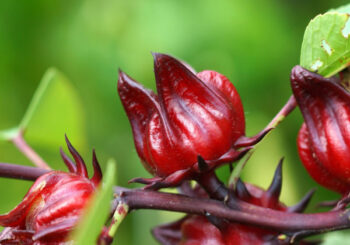By Sayer Ji
Contributing writer for Wake Up World
Hibiscus sabdariffa, also known as Roselle, Florida cranberry and Jamaica sorrel, is a plant closely related to okra that’s native to Central and West Africa.[i] The calyces of the hibiscus flower — the bright red, cup-shaped structures — have a tart, cranberry-like flavor and are enjoyed as part of a special holiday beverage in the Caribbean.[ii]
[pro_ad_display_adzone id=”110028″]
Hibiscus also has a long history of use in folk medicine in Thailand, Nigeria, China and India.[iii] Bioactive compounds in the plant are plentiful and include flavonoids, anthocyanins and chlorogenic acid, with known antioxidant, anti-inflammatory and anticancer effects — and additional benefits for diabetes control and the prevention of heart disease and obesity.[iv]
Hibiscus’ anti-obesity effects are particularly exciting, with research showing this powerful plant may hold a natural secret to helping humans stay slim.
Hibiscus Extract Safely Inhibits Obesity
Researchers with Chung-Shan Medical University, Taiwan, looked at the effects of hibiscus extract (HSE) on metabolic regulation in a group of overweight or obese adults, ages 18 to 65.[v] Participants received either HSE — at a dose of 450 milligrams (mg) — or a placebo capsule containing 500 mg of starch daily for 12 weeks. The hibiscus extract led to a number of beneficial effects on obesity as well as liver health.
Those in the HSE group had decreased body weight, body mass index (BMI) and body fat, as well as reduced abdominal fat distribution. Serum free fatty acids, which tend to be elevated in people with obesity, also decreased, while fatty liver disease improved.
“Noticeably, the safety evaluation revealed that HSE did not harm the human body,” the researchers noted.[vi] They included a breakdown of functional ingredients in HSE that likely contributed to the impressive anti-obesity and liver-protective effects shown in the study:[vii]
|
HSE Functional Ingredient |
Function |
|
Galloyl ester |
Decreases body weight and liver fat |
|
Chlorogenic acid |
Decreases body weight regulates obesity-related hormone and lipid metabolism and inhibits fatty liver |
|
Caffeic acid |
Decreases body weight, regulates obesity-related hormone and lipid metabolism, inhibits liver fat storage, promotes liver fat breakdown |
|
Quercetin |
Inhibits fatty liver and favorably influences fat cells |
|
Tiliroside |
Regulates obesity-related hormone and promotes liver fat breakdown |
|
Anthocyanins |
Decrease body weight and body fat, improve serum and liver fat profiles, ameliorate impaired liver function |
Hibiscus Fights Obesity Multiple Ways
Hibiscus targets various aspects of obesity, which may explain why it appears so effective for weight control. Among them, polyphenols from hibiscus may help regulate:[viii]
|
Energy metabolism |
Oxidative stress |
|
Inflammatory pathways |
Transcription factors |
|
Hormones and peptides |
Digestive enzymes |
|
Epigenetic modifications |
Hibiscus polyphenols are also xenohormetic agents, which describe bioactive compounds produced when plants are stressed, which then confer benefits to the animals that consume them.[ix] Anthocyanins, which are responsible for hibiscus’ bright red flowers, are one example, and it’s believed their antioxidant effects are responsible for some of the plant’s health benefits, though not all.
One study also revealed that different colored hibiscus led to different health benefits related to obesity and insulin resistance. Alma blanca, a white-yellow hibiscus variety rich in organic and phenolic acids, surprisingly had greater anti-obesity and antidiabetic effects in rats, compared to Cuarenteña, a purple variety.[x]
79 More Reasons to Consider Hibiscus
Bioactive compounds in hibiscus may benefit 79 diseases, including high blood pressure, diabetes, endothelial disorders and kidney stones. In fact, drinking hibiscus tea twice a day may be enough to manage blood pressure in stage 1 hypertension, along with lifestyle and dietary changes.[xi]
[pro_ad_display_adzone id=”110030″]
At our GreenMedInfo.com hibiscus research database, you can also read about 50 pharmacological actions of hibiscus, such as antibacterial, neuroprotective, renoprotective and hypolipidemic effects. The antiviral effects of hibiscus also make it useful for warding off avian flu, while it also shows promise for reversing metabolic syndrome. Regularly consuming hibiscus can even lead to reductions in blood pressure similar to those resulting from medication.[xii]
In addition to consuming hibiscus in extract or tea forms, hibiscus calyx can be used in your everyday cooking. Chopped calyces can take the place of cranberries in cranberry sauce, for instance, or can be made into jam or added to salads. Hibiscus calyces can also be used in place of rhubarb to give a tart kick to desserts or sauces. Hibiscus seeds can even be roasted and brewed, similar to coffee, while hibiscus leaves can be eaten raw or cooked.[xiii]
The simplest way to start out with hibiscus, if you’re new to this food, is to try it out in tea form. It has a pleasant, tart flavor, which is why it’s sometimes referred to as “sour tea.” In a study of 21 adults, those who drank hibiscus tea felt less hungry and had a greater feeling of satiety and fullness than those who did not. Women also burned more fat after eating when they consumed hibiscus tea.[xiv]
Further, drinking hibiscus tea may benefit a number of risk factors for heart disease, including triggering significant reductions in fasting plasma glucose, systolic blood pressure and diastolic blood pressure.[xv] Hibiscus tea can be enjoyed any time of day. However, it’s caffeine-free and certain varieties offer some anxiety-relieving and sedative effects,[xvi] so many people like to drink it before bed or when they’re in need of stress relief.
References:
[i] University of Florida, Roselle https://gardeningsolutions.ifas.ufl.edu/plants/edibles/vegetables/roselle.html
[ii] University of Florida, Roselle https://gardeningsolutions.ifas.ufl.edu/plants/edibles/vegetables/roselle.html
[iii] Molecules. 2019 Jan; 24(1): 210. https://www.ncbi.nlm.nih.gov/pmc/articles/PMC6337177/
[iv] Molecules. 2019 Jan; 24(1): 210. https://www.ncbi.nlm.nih.gov/pmc/articles/PMC6337177/
[v] Food Funct. 2014 Apr;5(4):734-9. doi: 10.1039/c3fo60495k. Epub 2014 Feb 19. https://sci-hub.ru/10.1039/c3fo60495k
[vi] Food Funct. 2014 Apr;5(4):734-9. doi: 10.1039/c3fo60495k. Epub 2014 Feb 19. https://sci-hub.ru/10.1039/c3fo60495k
[vii] Food Funct. 2014 Apr;5(4):734-9. doi: 10.1039/c3fo60495k. Epub 2014 Feb 19., Table 4 https://sci-hub.ru/10.1039/c3fo60495k
[viii] Nutrients. 2017 Aug; 9(8): 907. https://www.ncbi.nlm.nih.gov/pmc/articles/PMC5579700/
[ix] Nutrients. 2017 Aug; 9(8): 907. https://www.ncbi.nlm.nih.gov/pmc/articles/PMC5579700/
[x] Int J Environ Res Public Health. 2022 Dec; 19(24): 16538. https://www.ncbi.nlm.nih.gov/pmc/articles/PMC9779630/
[xi] J Adv Pharm Technol Res. 2019 Jul-Sep;10(3):107-111. doi: 10.4103/japtr.JAPTR_402_18. https://pubmed.ncbi.nlm.nih.gov/31334091/
[xii] Nutr Rev. 2022 May 9;80(6):1723-1737. doi: 10.1093/nutrit/nuab104. https://pubmed.ncbi.nlm.nih.gov/34927694/
[xiii] University of Florida, Roselle https://gardeningsolutions.ifas.ufl.edu/plants/edibles/vegetables/roselle.html
[xiv] Appl Physiol Nutr Metab. 2022 Apr;47(4):429-438. doi: 10.1139/apnm-2021-0051. Epub 2021 Aug 9. https://pubmed.ncbi.nlm.nih.gov/34370964/
[xv] Phytother Res. 2020 Feb;34(2):329-339. doi: 10.1002/ptr.6541. Epub 2020 Jan 14. https://pubmed.ncbi.nlm.nih.gov/31943427/
[xvi] Afr J Med Med Sci. 2008 Mar;37(1):49-54. https://pubmed.ncbi.nlm.nih.gov/18756855/
About the author:
Sayer Ji is the founder of Greenmedinfo.com, a reviewer at the International Journal of Human Nutrition and Functional Medicine, Co-founder and CEO of Systome Biomed, Vice Chairman of the Board of the National Health Federation, and Steering Committee Member of the Global Non-GMO Foundation.
© 2020 GreenMedInfo LLC. This work is reproduced and distributed with the permission of GreenMedInfo LLC. Want to learn more from GreenMedInfo? Sign up for their newsletter here.
[pro_ad_display_adzone id=”110027″]








